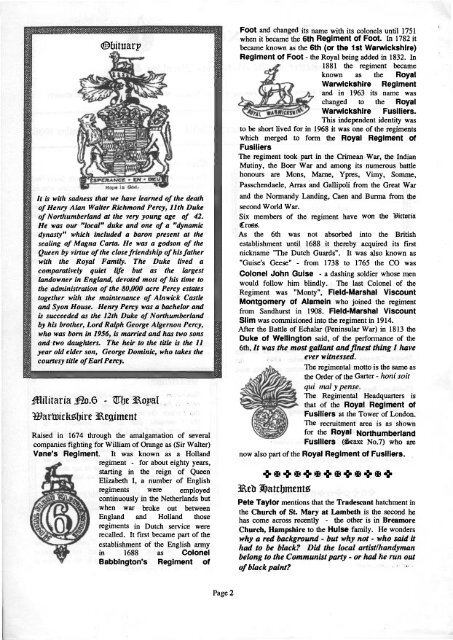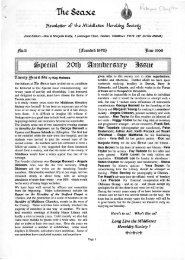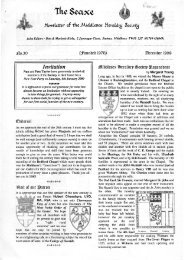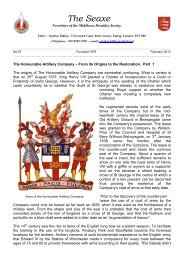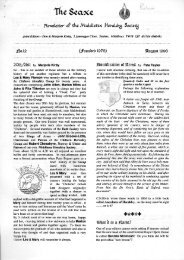The Seaxe - Middlesex Heraldry Society
The Seaxe - Middlesex Heraldry Society
The Seaxe - Middlesex Heraldry Society
You also want an ePaper? Increase the reach of your titles
YUMPU automatically turns print PDFs into web optimized ePapers that Google loves.
Obituary<br />
It is with sadness that we have learned of the death<br />
of Henry Alan Walter Richmond Percy, 11th Duke<br />
of Northumberland at the very young age of 42.<br />
He was our "local" duke and one of a "dynamic<br />
dynasty" which included a baron present at the<br />
sealing of Magna Carta. He was a godson of the<br />
Queen by virtue of the close friendship of his father<br />
with the Royal Family. <strong>The</strong> Duke lived a<br />
comparatively quiet life but as the largest<br />
landowner in England, devoted most of his time to<br />
the administration of the 80,000 acre Percy estates<br />
together with the maintenance of Alnwick Castle<br />
and Syon House. Henry Percy was a bachelor and<br />
is succeeded as the 12th Duke of Northumberland<br />
by his brother, Lord Ralph George Algernon Percy,<br />
who was born in 1956, is married and has two sons<br />
and two daughters. <strong>The</strong> heir to the title is the 11<br />
year old elder son, George Dominic, who takes the<br />
courtesy title of Earl Percy.<br />
Militaria No.6 - <strong>The</strong> Royal<br />
Warwickshire Regiment<br />
Raised in 1674 through the amalgamation of several<br />
companies fighting for William of Orange as (Sir Walter)<br />
Vane's Regiment. It was known as a Holland<br />
regiment - for about eighty years,<br />
starting in the reign of Queen<br />
Elizabeth I, a number of English<br />
regiments were employed<br />
continuously in the Netherlands but<br />
when war broke out between<br />
England and Holland those<br />
regiments in Dutch service were<br />
recalled. It first became part of the<br />
establishment of the English army<br />
in 1688 as Colonel<br />
Babbington's Regiment of<br />
Page 2<br />
Foot and changed its name with its colonels until 1751<br />
when it became the 6th Regiment Of Foot. In 1782 it<br />
became known as the 6th (or the 1st Warwickshire)<br />
Regiment Of Foot - the Royal being added in 1832. In<br />
1881 the regiment became<br />
known as the Royal<br />
Warwickshire Regiment<br />
and in 1963 its name was<br />
changed to the Royal<br />
Warwickshire Fusiliers.<br />
This independent identity was<br />
to be short lived for in 1968 it was one of the regiments<br />
which merged to form the Royal Regiment Of<br />
Fusiliers<br />
<strong>The</strong> regiment took part in the Crimean War, the Indian<br />
Mutiny, the Boer War and among its numerous battle<br />
honours are Mons, Marne, Ypres, Vimy, Somme,<br />
Passchendaele, Arras and Gallipoli from the Great War<br />
and the Normandy Landing, Caen and Burma from the<br />
second World War.<br />
Six members of the regiment have won the Victoria<br />
Cross.<br />
As the 6th was not absorbed into the British<br />
establishment until 1688 it thereby acquired its first<br />
nickname "<strong>The</strong> Dutch Guards". It was also known as<br />
"Guise's Geese" - from 1738 to 1765 the CO was<br />
Colonel John Guise - a dashing soldier whose men<br />
would follow him blindly. <strong>The</strong> last Colonel of the<br />
Regiment was "Monty", Field-Marshal Viscount<br />
Montgomery of Alamein who joined the regiment<br />
from Sandhurst in 1908. Field-Marshal Viscount<br />
Slim was commissioned into the regiment in 1914.<br />
After the Battle of Echalar (Peninsular War) in 1813 the<br />
Duke Of Wellington said, of the performance of the<br />
6th, It was the most gallant and finest thing I have<br />
ever witnessed.<br />
<strong>The</strong> regimental motto is the same as<br />
the Order of the Garter - honi soit<br />
qui mal y pense.<br />
<strong>The</strong> Regimental Headquarters is<br />
that of the Royal Regiment of<br />
Fusiliers at the Tower of London.<br />
<strong>The</strong> recruitment area is as shown<br />
for the Royal Northumberland<br />
Fusiliers (<strong>Seaxe</strong> No.7) who are<br />
now also part of the Royal Regiment of Fusiliers.<br />
Red Hatchments<br />
Pete Taylor mentions that the Tradescant hatchment in<br />
the Church of St Mary at Lambeth is the second he<br />
has come across recently - the other is in Breamore<br />
Church, Hampshire to the Hulse family. He wonders<br />
why a red background - but why not - who said it<br />
had to be black? Did the local artist/handyman<br />
belong to the Communist party - or had he run out<br />
of black paint?


